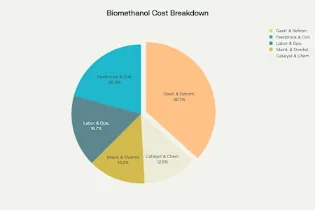Biomethanol: A Renewable Solution for Decarbonizing Industry
Biomethanol is becoming an important renewable alternative to fossil-based methanol. It provides a way to reduce carbon emissions in the chemical industry while supporting circular economy principles. Produced from sustainable feedstocks such as organic waste, agricultural residues, and pulp byproducts, biomethanol decreases reliance on fossil fuels and cuts carbon emissions across industrial and transportation sectors. Here’s an overview of its role, production methods, and challenges:
Production Methods and Technological Advances
Gasification of biomass: Johnson Matthey’s synthesis technology converts biomass or waste-derived syngas into high-purity biomethanol. It achieves high conversion rates and stable processes, even with impurities in the feedstocks. Their flexible design includes green hydrogen to improve yields and lower carbon impact.
Pulp mill integration: Veolia’s biorefinery in Finland produces 12,000 tons of CO₂-neutral biomethanol each year from crude sulfate methanol during pulp production. This model, which can be replicated at 80% of global pulp mills, could produce 2 million tons of biomethanol feedstock.
Direct CO₂ hydrogenation: New methods mix biogas with green hydrogen, but current economic analyses show that steam reforming is still slightly cheaper.
Applications in Decarbonization
Maritime fuel: Biomethanol can replace heavy fuel oil in shipping, potentially preventing 30,000 tons of CO₂ each year per facility.
Chemical feedstock: It is used to make formaldehyde, olefins, and acetic acid, which reduces emissions in plastic and adhesive manufacturing.
Biofuels: It supports the production of sustainable aviation fuel (SAF) and bio-gasoline, which helps address hard-to-decarbonize transport sectors.
Environmental and Economic Benefits
Circular economy: It uses waste streams like municipal solid waste and agricultural residues to reduce landfill emissions and conserve resources.
Carbon reduction: Veolia’s project achieves CO₂ neutrality by replacing fossil fuels, while Johnson Matthey’s process reduces emissions through better synthesis.
Energy security: Local production models, such as Veolia’s pulp mill integration, lessen the dependence on imported fossil fuels.
Challenges and Considerations
Feedstock limitations: Scalability depends on consistent waste biomass availability, with centralized plants facing feedstock logistics challenges.
Cost competitiveness: Biomethanol remains costlier than fossil-based methanol, though grants (e.g., Finland’s €50M investment) and carbon pricing could bridge the gap.
Technological maturity: Direct CO₂ hydrogenation requires equipment innovation to reduce costs, while gasification needs impurity-tolerant catalysts.
Future Outlook
The biomethanol market is poised for growth, driven by EU decarbonization policies and industrial partnerships. Projects like Veolia’s demonstrate scalability, while R&D focuses on hybrid systems combining green hydrogen and biomass gasification. For widespread adoption, advancements in decentralized production and policy incentives will be critical to offset higher production costs.
Biomethanol’s versatility as both a chemical precursor and fuel positions it as a linchpin in the transition to a low-carbon industrial ecosystem.
Stay Updated on Renewable Energy Solutions
Subscribe to receive the latest insights on sustainable chemistry and decarbonization technologies.
Subscribe Now
Biomethanol: Leading the Decarbonization of Chemical Industry
Conclusion
Biomethanol stands at the forefront of the chemical industry’s decarbonization journey. Its ability to transform waste biomass into a versatile, low-carbon feedstock and fuel underscores its pivotal role in achieving a sustainable, circular economy.
As production technologies mature and costs decline, biomethanol will become indispensable for reducing greenhouse gas emissions across chemicals, fuels, and hard-to-abate sectors such as shipping and aviation.
Transitioning beyond fossil feedstocks to biomethanol is not just an environmental imperative—it is a strategic opportunity to innovate, create resilient supply chains, and lead the chemical industry into a greener future.
Join the Sustainable Chemistry Movement
Subscribe for updates on renewable feedstocks, green chemistry innovations, and industry decarbonization strategies.
Get Industry Insights📚 Related Articles
Dive deeper into the world of biomethanol and sustainable energy
Beyond Fossil Feedstock: Biomethanol’s Role in Decarbonizing Industry
Explore how biomethanol is revolutionizing the chemical industry by replacing fossil-based feedstocks with sustainable alternatives.
Investing in Biomethanol: Early-Stage Opportunities in Green Energy
Discover investment opportunities in the rapidly expanding biomethanol sector and understand the market potential.
Your Comprehensive Guide to Biomethanol Applications & Benefits
A complete guide covering biomethanol applications, benefits, and the pathway to a sustainable energy future.

